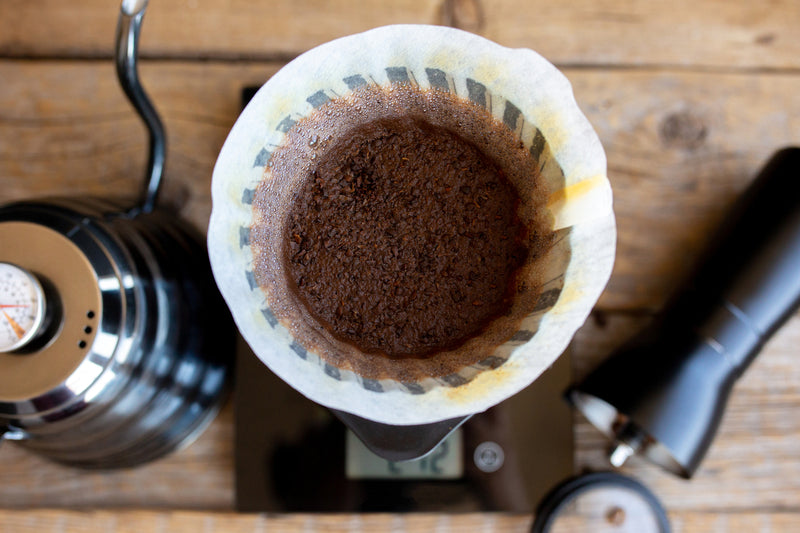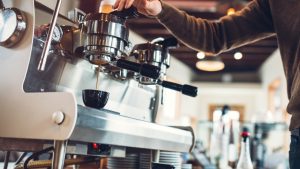Espresso makers work by forcing hot water through finely-ground coffee beans under high pressure, resulting in a concentrated shot of coffee. Espresso, known for its bold flavor and rich crema, is made using an espresso machine that uses a combination of pressure, temperature, and extraction time to produce the perfect shot.
The process begins by grinding coffee beans to a fine consistency. The grounds are then packed into a portafilter and leveled off. Next, hot water is forced through the coffee at high pressure, typically between 9 and 15 bars, extracting the flavors and oils from the beans.
The result is a concentrated and highly flavorful shot of espresso. This method of extraction allows for a shorter brew time and more intense coffee flavor compared to other brewing methods. Espresso makers are available in a range of designs, from manual lever machines to fully automatic models, offering coffee lovers the ability to enjoy their favorite brew at home.
Espresso Makers Unveiling: A Deep Dive
The popularity of espresso has soared in recent years, with an increasing number of people opting for this strong and flavorful coffee option. But have you ever wondered how espresso makers work to create that perfect cup of goodness?
Espresso makers use a combination of pressure and heat to extract the intense flavors from the coffee grounds. The process begins by finely grinding the coffee beans, ensuring a larger surface area for extraction. The coffee grounds are then packed tightly into a portafilter, which is then attached to the espresso machine.
Hot water is forced through the tightly packed coffee grounds at high pressure, typically around 9 bar, for a precise amount of time, usually around 25 seconds. This pressure and heat work together to produce a concentrated and intense shot of espresso.
Espresso machines come in various types, such as manual, semi-automatic, and fully automatic. These machines offer different levels of control and convenience, allowing coffee lovers to choose the option that suits their preferences.
So, the next time you enjoy a delicious cup of espresso, you can appreciate the intricate process that goes into making it. Cheers to the perfect balance of pressure, heat, and coffee!
Anatomy Of Espresso Machines
Espresso machines have a fascinating anatomy, consisting of key components that work together to deliver the perfect cup of coffee. The water reservoir acts as the source, supplying water for the brewing process. The boiler or heating element ensures the water reaches the ideal temperature for extraction. The pump generates the necessary pressure to force water through the coffee grounds and produce the rich, concentrated espresso. The portafilter holds the coffee grounds during the extraction process. The group head is where the coffee meets the machine, connecting the portafilter to the water and heat source. The steam wand is used to texture milk for lattes and cappuccinos, adding a creamy and velvety touch.
There are various types of espresso machines available. Manual lever machines offer a traditional and hands-on approach, requiring the user to control the extraction process. Semi-automatic machines strike a balance between control and convenience, allowing users to adjust settings while also automating certain aspects. Fully automatic machines provide push-button simplicity, handling the brewing process from start to finish. Super-automatic machines take convenience a step further by automating everything from grinding the beans to brewing the espresso. For those seeking ultimate convenience, capsule machines offer a quick and easy way to enjoy espresso at the press of a button.
| Types of Espresso Machines | |
|---|---|
| Manual Lever Machines | Traditional Approach |
| Semi-Automatic | Balancing Control and Convenience |
| Fully-Automatic | Push-Button Simplicity |
| Super-Automatic | From Bean to Cup |
| Capsule Machines | Espresso at the Press of a Button |
Espresso Machine Mechanics: Brewing Basics
Espresso makers work by utilizing water pressure, precise temperature control, coffee grounds, and perfect timing to create a rich and flavorful cup of espresso.
Water pressure plays a crucial role in the brewing process. The machine forces water through tightly packed coffee grounds using high pressure. This pressure extracts the aromatic oils and flavor compounds from the coffee, resulting in a concentrated and full-bodied espresso.
Precise temperature control is vital for flavor optimization. The water used in espresso machines is heated to a specific temperature, usually between 195 to 205 degrees Fahrenheit. This temperature ensures that the coffee extracts the desired flavors without becoming bitter or acidic.
The size of the coffee grounds also matters. The grounds need to be fine and consistent to allow for maximum extraction during the brewing process.
Tamping is another important step. The coffee grounds are evenly distributed and then firmly packed down into the espresso machine’s portafilter. This compaction ensures that the water passes through the coffee evenly, resulting in a more balanced and flavorful extraction.
Finally, timing is crucial. The water passes through the coffee grounds for a specific amount of time, usually between 20 to 30 seconds. This carefully controlled timing allows for the extraction of the desired flavors while preventing over-extraction or under-extraction.
Espresso Science: Perfection In A Cup
Water quality plays a crucial role in the art of espresso making. It’s more than just a fluid; it is the essence that unlocks the flavors of coffee. The extraction process comprises several phases. Pre-infusion is the initial contact between the grounds and water. During this phase, the coffee bed is saturated, allowing the flavors to bloom.
The main extraction phase follows, where hot water passes through the coffee bed, extracting the oils, sugars, and acids that give espresso its rich taste. The pressure profiles applied during this phase can be customized to achieve the desired brew.
Troubleshooting espresso imperfections is also essential. Under-extraction occurs when the brew time is too short, resulting in weak flavors and sourness. Over-extraction, on the other hand, leads to bitterness and burnt flavors. Proper water distribution is vital to avoid channeling, which can cause uneven extraction.
| Imperfection | Symptoms | Solutions |
|---|---|---|
| Under-extraction | Weak flavors, sourness | Adjust grind size, increase brew time |
| Over-extraction | Bitterness, burnt flavors | Adjust grind size, decrease brew time |
| Channeling | Uneven extraction | Distribute grounds evenly, adjust tamp pressure |
Espresso Mastery: Tips And Techniques
Espresso machines work by utilizing pressure and heat to extract the best flavors from freshly ground coffee. To achieve espresso mastery, it’s essential to understand the tips and techniques that can elevate your brewing skills.
When it comes to dialing in your espresso, adjusting variables such as grind size, coffee dose, and extraction time can greatly impact the taste. Experimenting with these variables will help create the perfect balance for your palate.
Maintenance is key in prolonging the lifespan of your espresso machine. Regular cleaning, descaling, and replacing worn-out parts will ensure optimal performance and prevent any unwanted issues.
To enhance your espresso experience, learning barista secrets is invaluable. Techniques like milk steaming, latte art, and different brewing methods can open up a world of possibilities and take your espresso to the next level.

Espresso Enthusiast’s Exploration: Advanced Concepts
Espresso enthusiasts are often intrigued by the advanced concepts involved in the process, such as the role of crema in espresso quality. Crema, a velvety layer of foam on top of an espresso shot, contributes to the aesthetic appeal and flavor profile. It is formed when hot water is forced through finely ground coffee under high pressure, creating a rich extraction. This unique brewing method sets espresso apart from other alternative brewing methods.
Espresso machines have evolved over time, with innovations and trends shaping the future of coffee brewing. The introduction of complex technologies like semi-automatic and super-automatic machines has made home brewing more convenient. Additionally, advancements in grinder technology and pressure profiling allow for better control over the brewing process.
| Alternative Brewing Methods | Espresso |
|---|---|
| Aeropress | No |
| French Press | No |
| Pour Over | No |
| Cold Brew | No |
| Espresso | Yes |
Frequently Asked Questions For How Do Espresso Makers Work
What Is The Difference Between A Coffee Maker And An Espresso Machine?
A coffee maker brews regular coffee while an espresso machine makes concentrated coffee called espresso.
How Do Espresso Machines Generate Pressure?
Espresso machines generate pressure by using a powerful pump to force hot water through finely-ground coffee. The pump increases the pressure, which extracts flavor from the coffee beans and creates a rich, concentrated espresso.
Is Espresso Stronger Than Coffee?
Espresso is stronger than regular coffee because it is brewed with a smaller amount of water and finely ground beans, creating a concentrated and intense flavor.
Do You Use Regular Coffee In An Espresso Machine?
No, regular coffee cannot be used in an espresso machine. Espresso requires finely ground, specialized coffee beans and a specific brewing process to achieve its concentrated flavor and thick consistency.
How does an espresso machine create pressure?
Espresso machines use a pump to force water through the coffee grounds. Traditional machines have a lever or piston, while modern ones use electric pumps.
What is the ideal brewing temperature for espresso?
The water temperature should be around 195 to 205 degrees Fahrenheit (90.5 to 96.1 degrees Celsius) for optimal extraction.
Why is the grind size crucial for espresso?
Espresso requires a fine grind to create resistance, facilitating the build-up of pressure and extraction of flavors within a short time.
What is the “crema” in espresso?
Crema is the golden-brown layer of foam on top of a well-pulled shot. It consists of oils, proteins, and sugars emulsified during the brewing process.
Why is it essential to use freshly ground coffee beans?
Freshly ground beans preserve the volatile compounds responsible for the rich aroma and flavor in espresso. Pre-ground coffee loses these qualities more quickly.
How do you clean an espresso machine?
Regular cleaning is vital to prevent coffee oils and residues from affecting the taste. Follow the manufacturer’s guidelines for cleaning the portafilter, group head, and other components.
Can any coffee be used for espresso?
While any coffee can technically be used, espresso is typically made from a blend of Arabica and Robusta beans, roasted to a specific level for a balanced and bold flavor.
What is the difference between a single and double shot of espresso?
A single shot uses around 7-9 grams of coffee, producing about 1 ounce (30 ml) of liquid. A double shot uses 14-18 grams, yielding approximately 2 ounces (60 ml).
How long should it take to brew a shot of espresso?
The ideal extraction time is around 25-30 seconds. If it’s too fast, the coffee may be under-extracted; if too slow, it may be over-extracted, resulting in a bitter taste.
Why is the water pressure crucial in espresso making?
High pressure (typically 9 bars) helps extract flavors rapidly and create the unique characteristics of espresso, including the crema and concentrated taste.
Conclusion
Understanding how espresso makers work is key to enjoying a perfect cup of espresso. The combination of pressure, hot water, and finely ground coffee beans allows for the extraction of rich flavors and aromatic oils. By following the steps outlined in this blog post, you can confidently operate your espresso maker and elevate your coffee experience to a new level.
So, go ahead and indulge in the delightful world of espresso-making!





